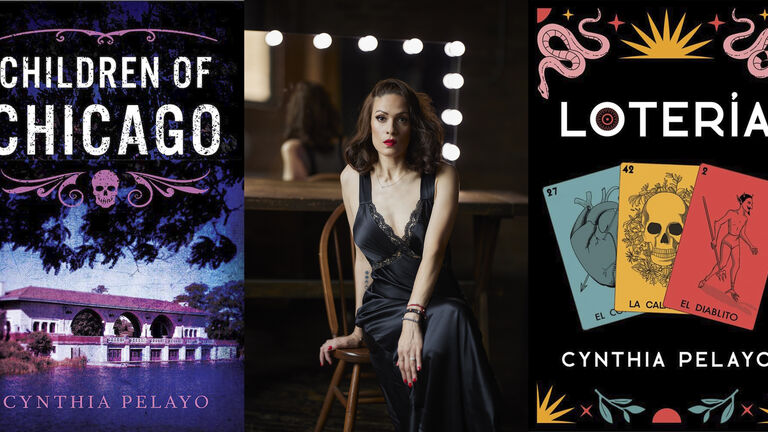
The Beautiful and Ominous Worlds of Cynthia Pelayo
Step into the eerie and captivating world of Cynthia Pelayo (MFA 2010), a literary sensation applauded for her perfectly calibrated prose and melodic poetry. In her works, Pelayo infuses the backdrops of historic Chicago with the enigmatic fog of horror, mystery, and suspense. Her novels defy predictability, blending folklore with timeless horror classics, keeping the reader on the edge of their seats until the very last page—the perfect read in the weeks leading up to Halloween…if you dare.
Pelayo has amassed numerous awards throughout her prolific career, becoming the first Latina and the first Puerto Rican to receive the prestigious Bram Stoker Award. Her MFA thesis work, Lotería, was spotlighted by Esquire as one of the “Best Horror Books of 2023.”
In this interview, Pelayo shares insights into her creative process, the deep roots of collective memory, and the topic of her undeniable expertise—horror.
When did you discover your passion for storytelling?
Storytelling surrounds most of us from childhood, and I was no exception. My Puerto Rican parents always recited folk tales to me, transporting me to thickets filled with monsters and ghosts. The folklore was not confined to my imagination—it was all around. We lived in a multi-unit house; my family occupied the downstairs, and my aunt and grandfather dwelled upstairs. One day, when I was around six, they left for a doctor’s appointment. Suddenly, I heard weird noises of slamming doors coming from the upstairs apartment. I ran to tell my father about the bizarre activity, and he replied ”We don’t talk about those things. It gives them power.”
I have always been surrounded by the supernatural, so the idea of it existing side-by-side with us is instinctive and visceral to me. In many of my stories, you can sense something unknown lurking between the lines of text, something that shouldn’t be named. Once you acknowledge it, you give it energy.
You mentioned your Puerto Rican roots, but you also grew up in Chicago. What role does the city play in your stories?
Places and cities are definitely their own characters in my stories.
I came to Chicago when I was two years old. I didn’t really know Puerto Rico as a home, but there has never been a doubt that it was a part of my background. My father would say: “You are a Latina; you speak Spanish; this is your cultural identity, but Chicago is your home.” He loved and took pride in both the city and the island.
I grew up in a non-traditional household for the ‘80s as my mom worked full-time while my father was the one who raised me as a stay-at-home dad. We loved exploring the city’s neighborhoods, delis, and coffee shops together. That is when I became fascinated with Chicago, its eclectic and multifaceted spirit. We have a dark history here with Al Capone, H. H. Holmes, and John Wayne Gacy. Some of the nation’s most tragic events occurred as well: the Iroquois Theater Fire, Flight 191 Crash, SS Eastland Disaster… At the same time, this is where Walt Disney was born, and L. Frank Baum wrote The Wonderful Wizard of Oz. It is definitely not a usual city—a strange locale where the beautiful and the tragic merge.
Why do you feel drawn to true crime, noir, and horror? What do these genres offer that others can’t?
I started off my writing career as a journalist, covering community news ranging from crime to art. However, as I kept writing, I noticed that the number of crime stories soared while everything else faded into the background. It was traumatic observing so many calamities happen, even at a distance, which made me quit my reporting job. I still wanted to write but did not know how to process the tragedies I had witnessed. That was why I applied to the School of the Art Institute of Chicago.
I wasn’t a typical candidate for the program that is mainly focused on fiction and poetry, but they believed that I wanted to explore. I remember one of my advisors, Ruth Margraff, telling me, “You are a horror writer who doesn’t know she is a horror writer,” because I would start writing realism, and suddenly, ghosts would appear, accompanied by a murder case to solve. My writing practice is where I can explore the human psychology of grief and mourning—it has become my version of therapy.
How does your poetic practice differ from your approaches to prose?
I have always thought of my novels as math problems–in fiction, the beginning has to take the reader to the end, so there is a problem with how to get from point A to point B. On the other hand, poetry is meditative, and if I am to extend the metaphor of a novel being a math problem, poetry can be compared to music. That is why every sound and syllable is significant–they carry the melody of a poem.
It sounds like SAIC greatly affected your artistic trajectory. Did you experience the influence of other art disciples while studying at the School?
Most definitely. I would not be the writer I am today without my SAIC experience. I didn’t quite have a set direction initially and loved having the ability to explore across genres and forms. Even within my home Writing Department, I had a chance to take courses on detective fiction, Grimm’s fairy tales, playwriting, Beckett, and Salinger—a range that not many institutions can offer. Investigating various narrative structures and tropes allowed me to utilize my journalistic core to develop my own model of fiction. SAIC gave me the confidence and bravery to explore.
What is your piece of advice for young creatives who are just beginning their careers?
Unfortunately, I don't have an easy recipe for success in the creative field. Time management is a crucial skill you need to have in any career since nothing will get done unless you do it yourself. You have to take the initiative and set your own timeframe and deadlines. I will also say, however, that having proper rest is paramount. Never feel guilty if a day or two go by and you don't make art because rest is a crucial part of creation—it is when bits and pieces of ideas start coming together.
